Table of Contents
Volcanoes
This article deals with ‘Volcanoes.’ This is part of our series on ‘Geography’ which is important pillar of GS-1 syllabus . For more articles , you can click here
What are volcanoes?
A volcano is an opening in the earth’s crust through which magma, gases and ash are released to the earth’s surface.
Related terminology
| Magma | The molten rock material found in the interior of the earth is called magma. |
| Lava | When magma reaches the earth’s surface, it is known as lava. |
| Vent | Vent is an opening or mouth of a volcano. |
| Fumaroles | – Fumaroles are the gushing fumes (fume = smoke) through the gap in the vicinity of volcano. – Fumaroles are often in the neighbourhood of volcanoes. |
| Crater | Crater is a saucer shaped depression in the mouth of a volcano. |
| Caldera | When the crater is widened, it is called as Caldera |
| Volcanic Ash | Volcanic ash consists of fragments of pulverized rock, minerals and volcanic glass, created during volcanic eruptions. |

Causes of Volcanism
- Weak Zones in the Earth Crust: The parts of the earth where two tectonic plates collide against or drift apart from each other are considered very weak. Volcanoes may erupt in such zones, for example, African and Eurasian plates.
- Magma Saturated with Gases : The magma, in the interior of the earth, is often found saturated with gases like carbon dioxide, and hydrogen sulphide. These gases together with water vapour make the magma highly explosive. Magma is forced out as lava on the surface of the earth due to the pressure exerted by these gases.
Basaltic Eruption vs Andesitic Eruption
| Basaltic Eruption | Andesitic Eruption |
| Occur at mid oceanic ridge & Hotspot volcanism | Occur at Volcanic Island arcs & volcanic mountains |
| Basalt is highly fluid & mobile | Andesite is less fluid & less mobile |
| Spread across easily | Solidifies at short distance |
| Quite eruption | Explosive eruption |
| Form plateaus and island groups. | Forms volcanic peaks |
Types of Volcanoes
1 . Classification on basis of form developed
Volcanoes are classified on the basis of nature of eruption and the form developed at the surface.
a . Shield Volcanoes
- These are made up of basalt, a type of lava that is very fluid when erupted. Since Basalt is very fluid , it make these volcanoes less steep.
- Eg : Hawaiian volcanoes are the most famous examples.
- They become explosive if water gets into the vent; otherwise, they are characterised by low-explosivity.
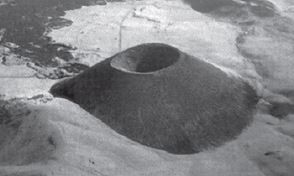
b. Composite Volcanoes
- Composite volcanoes are cone-shaped volcanoes composed of different layers of lava, ash and rock debris.
- Magma which erupt in this case is Andesitic in nature . Hence, eruption is violent and explosive. Along with that, Andesitic lava is less fluid making the Composite volcanoes very steep.
- Along with lava, large quantities of pyroclastic material also comes out.
- Examples include Mt Stromboli , Mt Vesuvius, Mt St Helens, Mt Fuji etc.

c. Caldera
- These are the most explosive of the earth’s volcanoes.
- They are usually so explosive that when they erupt they tend to collapse on themselves .The collapsed depressions are called calderas.
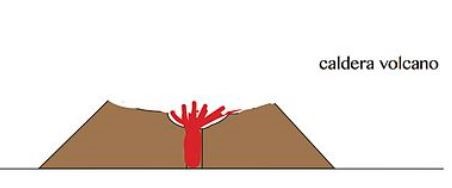
d. Flood Basalt Provinces
- These volcanoes out-pour highly fluid lava that flows for long distances.
- There can be a series of flows with some flows attaining thickness of more than 50 m.
- Deccan Traps from India, covering most of the Maharashtra plateau, are a flood basalt province.
e. Mid Oceanic Ridge Volcanoes
- These volcanoes occur in the oceanic areas at points where Oceanic – Oceanic tectonic plates diverges.
- There is a system of mid-ocean ridges more than 70,000 km long that stretches through all the ocean basins.
- The central portion of this ridge experiences frequent but peaceful eruptions.
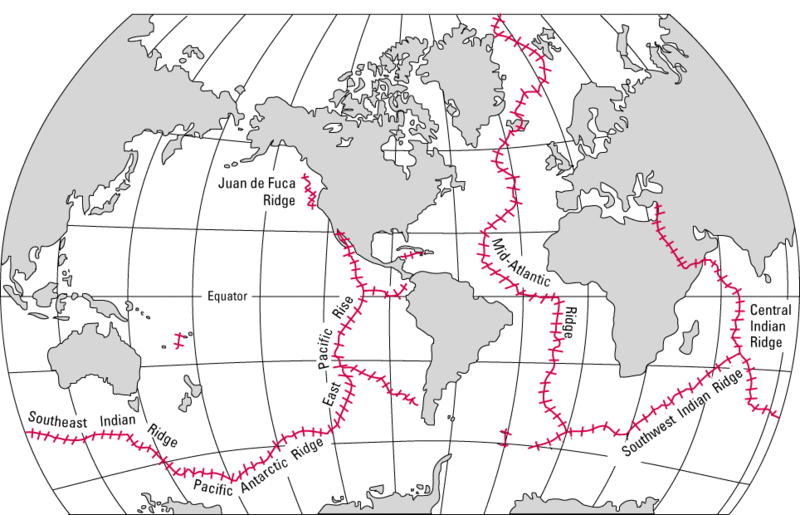
2. Classification on Basis of Periodicity of eruption
a. Active Volcanoes
- Volcanoes which erupt frequently.
- Generally, their vent remains open.
- Examples : Mount Etna of Italy, Cotopaxi in Ecuador (highest volcano) and many others situated in Pacific ring of fire .
b. Dormant Volcanoes
- These volcanoes may not have erupted in the recent past but there is a possibility of eruption at any time.
- Examples : Mt. Vesuvius of Italy , Mt. Fujiyama of Japan and Mt Kilimanjaro in Tanzania.
c. Extinct Volcanoes
- These volcanoes have exhausted their energy and have not erupted during the known geological period.
- Their Crater is generally filled with water making it a lake.
- Examples : Popa in Myanmar and Mt. Kenya in eastern Africa
Recent Volcanic Activities
| Barren Island | – Barren Island is in Andaman . – It again became active in 2017 – Earlier, it became active in 1991 and 1995. |
| Anak Krakatau | – It is in Indonesia – Latest eruption happened in April 2020 – Note : greatest volcanic explosion known to humans is Mt. Krakatau in August 1883. |
| Vulcan de Fuego | – Volcanic eruption happened in June 2018 – Here , Cocos plate is subducting under Caribbean plate. – It lies in the Pacific Ring of Fire in Guatemala |
| Kilauea Volcano | – Kilauea Volcano is situated in Hawaii . – It erupted in May 2018 |
| Mount Agung and Mount Sinabung | – They are in Bali – Eruption happen due to Oceanic -Oceanic Convergence of Indo-Australia and Sunda Plates – Volcanic eruptions happened in whole of 2018 |
Distribution of Volcanism
a. Ring of Fire
- Pacific Ring of Fire is the Circum-Pacific region that has the greatest concentration of active volcanoes. Two-third of world’s volcanoes lie here.
- Volcanoes are found here due to Oceanic -Oceanic & Oceanic-Continental Plate convergence .
| Oceanic – Oceanic Convergence | Results in formation of Volcanic Island Arcs. |
| Oceanic -Continental Convergence. | Volcanoes are formed |
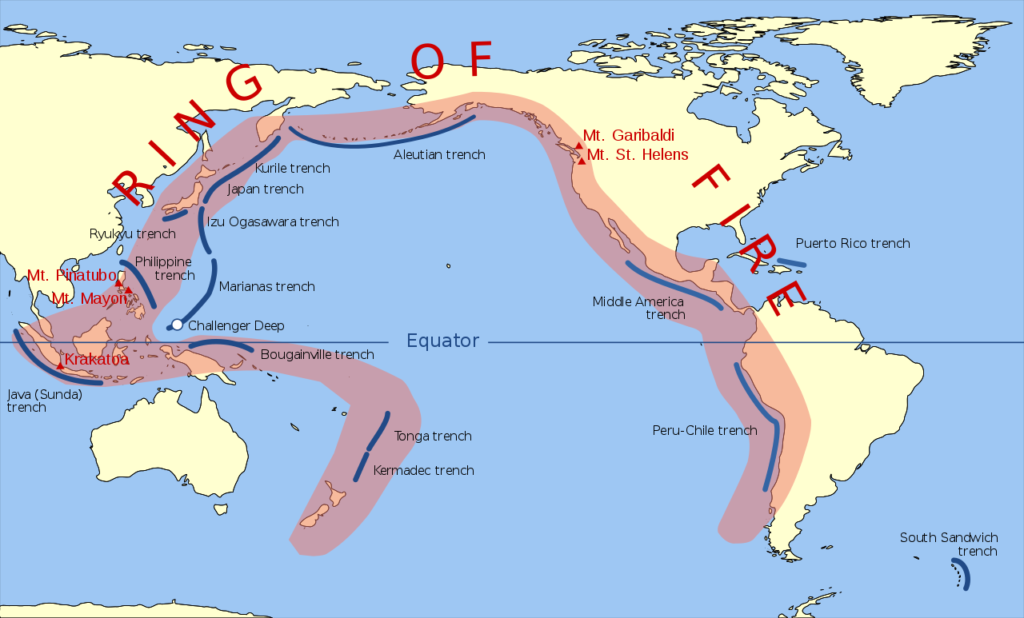
b. Mid Atlantic Region
- Formed due to Oceanic -Oceanic plate divergence .
- Basaltic Eruptions happens here which are peaceful in nature .
- Mid Oceanic Ridge Volcanoes are found here.
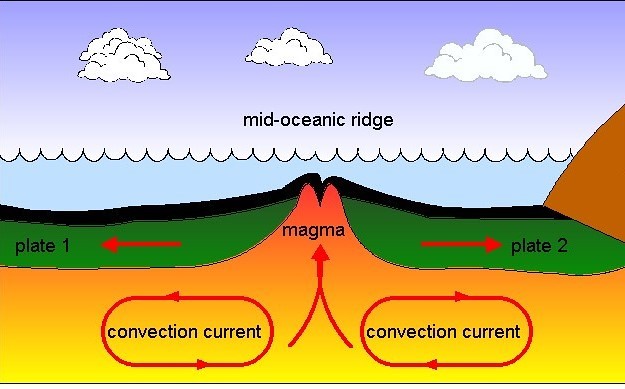
c. Great Rift Valley
- In Africa some volcanoes are found along the East African Rift Valley.
- Kilimanjaro and Mt. Kenya are extinct volcanoes. The only active volcano in West Africa is Mt. Cameroon.

d. Mediterranean Volcanism
- Volcanoes of the Mediterranean region are mainly associated with the Alpine folds.
- Examples : Mt. Vesuvius, Mt. Stromboli (known as the Light House of the Mediterranean Sea
e. Hotspot Volcanoes
- These have to do with plate tectonics .
- In these volcanoes, magma from the deep mantle come outside directly through plume .
- Lava is of Basaltic nature => Shield Volcanoes are formed in this activity which are not explosive.
- Their location remains fixed but plates on them can move leading to formation of island arcs or plateau depending upon conditions .
| In Oceans | Island Arc |
| On Continents | Volcanic Plateau |
- Eg Hawaii, Reunion Island , Kurile, Aleutian island , Iceland , Yellowstone (US Continental)
Lava / Volcanic Plateaus
- When Lava is basaltic (like in case of hotspots) , it can flow easily . It will keep on forming layer above layer.
- When this process goes on for large amount of time ,Lava Plateau is created .
- Eg: Deccan Plateau was formed in this way when Indian plate passed over Reunion Island hotspot during the cretaceous period.
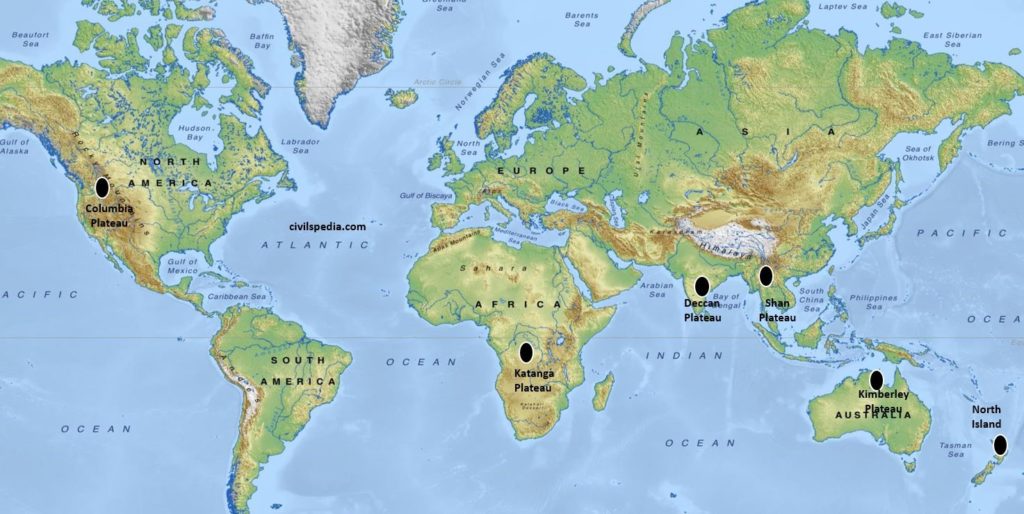
Side Topic : Formation of Deccan Plateau
- During Cretaceous Period , Indian Plate was moving northward and passed over Reunion islands (near Madagascar island in Indian Ocean)
- Hotspot volcanism was active over there which resulted in outpour of highly basaltic lava at that point . As the plate movement was extremely slow, India remained over the Reunion hotspot for a considerable long time which led to Basaltic deposits in Deccan area . Hence , Deccan Basaltic Plateau formed.
- 16-17 percent of India is under Deccan traps.
Intrusive Volcanic Landforms
We have studied about various landforms made by the volcanoes on the surface of earth. But volcanoes make large number of landforms inside the earth’s crust. These are called Intrusive Volcanic Landforms.

Intrusive Volcanic landforms are formed when magma fails to come out and solidifies under the Earth’s crust . Some of the landforms formed are as follows :-
a. Batholiths
- Batholiths are large rock domes formed due to cooling and solidification of hot magma inside the earth.
- They appear on the surface only after the denudational processes remove the overlying materials
- They are granitic in origin.
b. Laccoliths
- Laccoliths are formed when magma solidifies in cracks of sediments and take concave shape/ dome like shape
- Karnataka plateau is spotted with dome hills of granite rocks. These are exposed Laccoliths .
c. Phacoliths
- Phacoliths are formed when magma is filled in anticlines and synclines of folded mountains.
d. Sills
- Sills are parallelly solidified lava layers in sedimentary rocks in the interiors of Earth.
e. Dykes
- Longitudinally solidified magma in rocks is known as dyke.
Importance of Volcanic Activity
- Volcanism creates new landforms (all the landforms we have seen above)
- Volcanic rocks yield very fertile soil upon weathering and decomposition. For example black soil of Deccan Plateau in India is made for volcanic rocks and it is best suited to grow cotton .
- Source of Diamonds : Eg – Kimberlite rock of South Africa, the source of diamonds, is the pipe of an ancient volcano.
- Geothermal Energy : In the vicinity of active volcanoes, waters in the depth are heated from contact with hot magma giving rise to springs and geysers. The Puga valley in Ladakh region and Manikaran (Himachal Pradesh) are promising spots in India for the generation of geothermal electricity.
- Volcanism has also helped in the formation of atmosphere in the past. (How? – explained below)
Importance of Volcanic Activity in atmosphere formation in the past
- Degassing : Volcanic activity released essential gasses such as water vapor, carbon dioxide, methane, ammonia and very little free oxygen from the interior of the earth through a process called degassing.
- Volcanic eruptions injected ash and sulphur-rich aerosol clouds into the atmosphere which shaded sunlight and reduced the amount of solar radiation reaching the Earth’s surface thus cooling the planet. As the earth cooled, water vapor condensed to form rain dissolving carbon dioxide and other gases.
Side Topic : Impact of Volcanic eruptions on Climate Change
- Volcanic eruptions pour sulfur dioxide and other particles into the stratosphere. Gases react with water to form aerosols that linger in the stratosphere, reflecting sunlight and heat from the sun and thus lowering temperatures in the troposphere
- Intense volcanism has significantly increased the amount of carbon dioxide in the atmosphere and causes global warming. Volcanic eruptions produce more than 100 million tons CO2 each year. For Example: The 1980 eruption of Mount St. Helena vented approximately 10 million tons of CO2 into the atmosphere in only 9 hours.
- Dark lava flow absorbs more of the solar energy (low albedo) , so a large enough lava flow could warm a local region.
—> Volcanoes can have both a cooling and warming effect on climate. However, in the long term frequent volcanic eruptions will have a net effect of cooling the earth and counter global warming.
